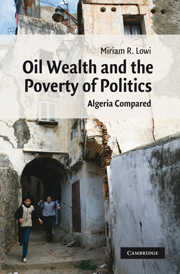Book contents
- Frontmatter
- Contents
- List of tables
- List of figures
- Preface
- Map of Algeria
- Part I Introduction
- Part II Algeria and its discontents
- 3 From conquest to independence
- 4 The elaboration of a system
- 5 From boom to bust, and … verging on breakdown
- 6 The persistence of violence and the process of re-equilibration
- Part III Comparisons and conclusions
- 8 Conclusions: oil wealth and the poverty of politics
- Bibliography
- Index
- CAMBRIDGE MIDDLE EAST STUDIES 32
4 - The elaboration of a system
Published online by Cambridge University Press: 29 March 2010
- Frontmatter
- Contents
- List of tables
- List of figures
- Preface
- Map of Algeria
- Part I Introduction
- Part II Algeria and its discontents
- 3 From conquest to independence
- 4 The elaboration of a system
- 5 From boom to bust, and … verging on breakdown
- 6 The persistence of violence and the process of re-equilibration
- Part III Comparisons and conclusions
- 8 Conclusions: oil wealth and the poverty of politics
- Bibliography
- Index
- CAMBRIDGE MIDDLE EAST STUDIES 32
Summary
Introduction
On the eve of independence, Algerian society displayed severe dislocations. There were close to 3 million people in centres de regroupement (“regroupment” or internment centers), over 300,000 refugees outside the country, and about 400,000 in prisons. Of a population of 10 million, 70 percent were rural and 30 percent urban. During the war years, more than 3 million, of a total of 8.5 million rural Algerians, had been displaced. Between 1954 and 1960, roughly three-quarters of a million people fled to the urban areas; the urban population increased by 67 percent. It would increase again when the French gave up the internment centers, since about half of those in the camps would go to the cities and establish themselves, most often in bidonvilles (shanty towns). Indeed, at independence, 55–65 percent of the urban population were migrants from the countryside who, in the cities, represented the bulk of the unemployed and underemployed (Ruedy 1992: 214; Bennoune 1988: 89–93). As John Ruedy (1992: 190) has indicated, “[I]t was with millions of impoverished, uprooted, culturally deprived, and bewildered ex-peasants that independent Algeria would begin the difficult task of restructuring itself.”
Over a four-month period, just preceding and immediately following independence, 90 percent of the European population – roughly 1 million people – abandoned their homes and workplaces and fled Algeria. They represented most of the private capital, as well as the professional, technical, and managerial expertise in the country.
- Type
- Chapter
- Information
- Oil Wealth and the Poverty of PoliticsAlgeria Compared, pp. 74 - 101Publisher: Cambridge University PressPrint publication year: 2009

